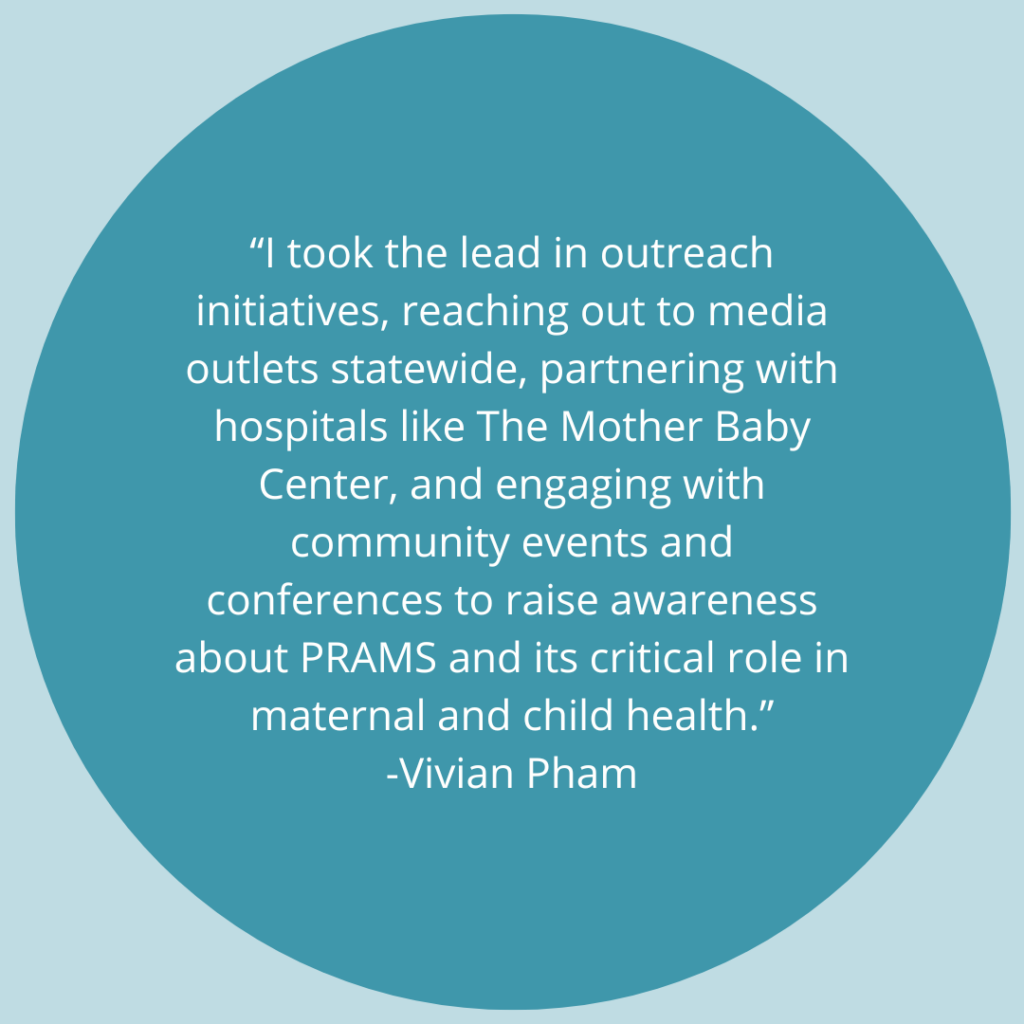#UMNMCH student, Vivian Pham (MPH 2024), wrote this reflection on how her deployment with Minnesota PRAMS has contributed to her transformative journey in MCH, shaping her into a steadfast advocate for the well-being of families and children worldwide.
My Journey to the MCH Program at UMN’s School of Public Health
My journey to where I am today has been a culmination of passion and discovery. It all began in my first year of undergrad at the University of Minnesota when I enrolled in Dr. Harry Lando and Dr. Sarah Sevcik‘s PUBH 3004 course on Personal and Community Health—a transformative experience that ignited my interest in public health. This passion only grew stronger as I delved deeper into the field, taking an introductory epidemiology course with Dr. Ruby Nguyen and eventually declaring a minor in public health. Even from a young age, the desire to care for mothers and babies has been deeply ingrained in me, fueling my aspirations to become a “baby doctor.” This desire prompted me to also pursue a degree in Developmental Psychology. Though my understanding of this profession has evolved over the years, the unwavering dedication to caring for mothers and children has remained a constant driving force. As my senior year of undergrad approached, my determination to continue my education in public health led me to the University of Minnesota’s School of Public Health, where I discovered their esteemed Maternal and Child Health program. It was a moment of clarity, a confirmation of my calling. The program’s diverse array of captivating courses, coupled with abundant research opportunities and a supportive community, solidified my decision. Now, as I embark on this next chapter of my academic and professional journey, I am energized by the opportunity to contribute to the advancement of public health, particularly in the realm of maternal and child health.
PRAMS: Unveiling the Foundation of Maternal and Child Health Surveillance
I had the great honor of being part of the Pregnancy Risk Assessment Monitoring System (PRAMS) team at the Minnesota Department of Health this past school year. Established in 1987 by the Centers for Disease Control and Prevention (CDC), PRAMS is a state-based surveillance initiative focused on maternal and infant health. As of 2021, 46 states, New York City, the District of Columbia, Puerto Rico, and the Northern Mariana Islands participate in PRAMS. PRAMS collects data through standardized questionnaires administered to recently postpartum women, aiming to understand maternal behaviors, experiences, and outcomes before, during, and after pregnancy. In Minnesota, PRAMS specifically targets improving the health of mothers and babies by reducing the risk of adverse birth outcomes such as low birthweight, preterm birth, as well as infant and maternal morbidity and mortality. By utilizing this data to identify factors associated with adverse pregnancy outcomes and disparities in maternal and child health, PRAMS informs the development of effective public health interventions and policies. Through its comprehensive approach, PRAMS continues to play a crucial role in improving maternal and infant health outcomes nationwide.
PRAMS in Action: Data Entry, Literature Review, Data Brief Development, Testing, and Outreach Initiatives
During my time with PRAMS, I refined my data entry skills, by primarily entering responses from the PRAMS questionnaires into the database, gaining first-hand insight into the meticulous process of collecting and analyzing data. Furthermore, reading through the survey results and comments left by mothers offered me a deeper understanding of the health inequities in our communities. Several respondents stated that they had limited to no time off of work for maternity leave. Others shared that they had to take unpaid leave, leading to further stress. Unpaid leave can increase financial strain, exacerbate anxiety about providing basic requirements, and intensify feelings of uncertainty and stress in mothers who already have to handle the demands of childbirth and early childcare. This eye-opening experience has further motivated me to advocate for health equity and strive toward addressing these disparities within maternal and child health initiatives.
I also participated in User Acceptance Testing (UAT) for Phase 9 of the survey, ensuring its accuracy and usability before implementation. UAT involves evaluating the program (in this case, survey) for any errors prior to it being released. This includes covering aspects such as language accuracy, survey response options, and question flow. Phase 9 involves the introduction of a new and revised PRAMS questionnaire. During this phase, changes are made to the survey instrument, such as updating questions, modifying response options, or restructuring the questionnaire layout. This experience highlighted the importance of thorough research preparation.
Additionally, I leveraged my time with PRAMS as an opportunity for my Applied Practice Experience (APEx). Under the guidance of my preceptor, I tackled diverse tasks, from conducting literature reviews to crafting a data brief and devising outreach strategies targeting PRAMS. Additionally, I took the lead in outreach initiatives, reaching out to media outlets statewide, partnering with hospitals like The Mother Baby Center, and engaging with community events and conferences to raise awareness about PRAMS and its critical role in maternal and child health. These multifaceted experiences not only enhanced my understanding of public health research and outreach but also reinforced my commitment to advocating for maternal and child health within communities.
Traversing Maternal and Child Health: Embracing the L.I.F.E. Framework at PRAMS
Utilizing the L.I.F.E. framework during my time at PRAMS has been instrumental in navigating the complexities of maternal and child health initiatives. In terms of leadership, I leveraged my strengths to foster collaboration and innovation within the team, ensuring effective communication and problem-solving. Interdisciplinary collaboration was central to our efforts, as we worked alongside professionals with diverse expertise to enhance data collection and analysis processes. In my role, I identified gaps in services, advocating for enhancements to better serve mothers and children in our community. By applying public health principles and leveraging PRAMS data, I played a role in ensuring that essential healthcare is equally accessible to all families, irrespective of their backgrounds. Embracing the principles of the L.I.F.E. framework provided me with valuable insights into the critical role of leadership, interdisciplinary collaboration, and equity in driving improvements in maternal and child health outcomes.
BIO
Vivian Pham is a second-year full-time MCH MPH student with additional interests in biostatistics, epidemiology, and health equity. Her journey began with a Bachelor of Science in Developmental Psychology from the University of Minnesota, Twin Cities in 2022. Building upon this foundation, she delved into clinical research, focusing on pediatric populations. She is a graduate research assistant for the Center for Research in Family Home Visiting (FHV) in the Department of General Pediatrics and Adolescent Health division at UMN and is a team member of the pediatric emergency medicine research team at a local hospital.
In her spare time, she enjoys playing tennis and pickleball. When she’s not on the courts, she is mastering the art of leisurely dog walks, trying to persuade her furry four-legged friend that squirrels are merely misunderstood. Despite her lactose intolerance, she fearlessly dives into ice cream, proving that rebellion comes in many different flavors! After graduation, Vivian aims to channel her passion and expertise in public health into a career in medicine, where she envisions herself as a determined physician committed to enhancing the welfare of underserved communities.
–Read Student Spotlight archives
Interested in learning more about getting a degree in MCH? Visit our MCH Program page for more information.
#UMNMCH #UMNproud #UMNdriven


